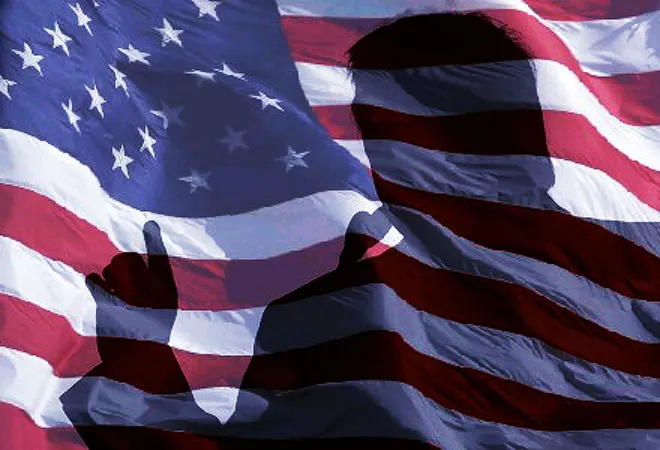
As the presumptive Democratic nominee and former Vice President Joe Biden remains confined to his basement, President Donald Trump has taken advantage of his role as the incumbent president to organise “thinly veiled campaign events” amidst the coronavirus pandemic. Trump recently visited a Ford manufacturing plant in Michigan, with the purpose of surveying its altered operations to produce ventilators. But Trump’s visit also came from the standpoint of his re-election bid.
Much-like his 2016 campaign, Trump’s focus once again seems to be on courting blue-collar workers. However, this time the bogeyman he is seeking to vilify is much closer to home.
Targeting Democrat governors
In his contest against Hillary Clinton, Trump pulled off a win in the swing-state of Michigan by a narrow margin. He galvanised white working-class voters by tapping into their anxieties on immigration and playing-up job losses in the mid-west due to America’s industry-base shifting to countries like China. This time, Trump is construing Democrats as the ones impeding his post-COVID-19 economic revival.
Biden has stepped up attacks on Trump’s unfulfilled promises, by alleging him to have “turned his back on Michigan's working families.” In response, Trump has singled out swing-states ruled by Democrats in his support for protestors “who chafe against social distancing as an infringement on freedoms.” Thus, at the Ford plant, Trump presented himself as the standard-bearer for those vying for an American economic reawakening: “Americans who want and need to return to work should not be vilified — they should be supported.”
Trump’s strategy of supporting local protests has emerged as the ideal approach by which he can avoid the elections from becoming a referendum on his handling of the pandemic.
Furthermore, as US states grappled against Trump’s slow-walked response to the coronavirus pandemic, Michigan Gov. Gretchen Whitmer emerged as a vocal critic of a meek federal response. Her rise to national prominence also fed speculations of her being picked as Biden’s Vice President. But on the local level, she has faced armed demonstrators in multiple rounds of protests at the Michigan State Capitol and reportedly has also been the subject of “credible threats” of assassination. Given her prospects with Biden and her role as a Democrat overseeing an electorally-crucial state, Trump’s strategy of supporting local protests has emerged as the ideal approach by which he can avoid the elections from becoming a referendum on his handling of the pandemic.
Thus, Trump has similarly focused on swing-states ruled by Democrats. Trump has alleged Pennsylvania Gov. Tom Wolf to have continued lockdowns without a credible rationale: “You have areas of Pennsylvania that are barely affected and to keep them closed.” And in Wisconsin, Trump’s anti-lockdown rhetoric has spurred local Republicans to call for “liberating” residents from stay-at-home orders by Gov. Tony Evers.
Repurposing the anti-swamp narrative
In the 2016, Trump often derided Clinton as being supported by the US political establishment or the “swamp”. In alleging that group of elites to have “rigged” the election against him, Trump further galvanised support for his conservative nationalist movement.
Trump is now repurposing that narrative to allege a deep-rooted conspiracy against his presidency. Calling it “the biggest political crime in American history,” Trump has accused his predecessor Barack Obama administration for “masterminding the Russia investigation and engineering a ‘deep state’ campaign to undermine Trump's presidency before it even began.”
In 2016, while alleging that group of elites to have “rigged” the election against him, Trump further galvanised support for his conservative nationalist movement.
The theory revolves around Trump campaign advisor and subsequently his National Security Advisor Michael Flynn. In 2017, Flynn pled guilty to lying to the FBI about his interactions with Russian diplomat Sergey Kislyak during the presidential transition. In the final days of the Obama administration, their conversations were recorded as part of routine US surveillance on Russian officials. Generally, the identity of any US citizen in such surveillance is redacted, but is open to “unmasking” requests by US officials. Under the alleged conspiracy, senior Obama officials “unmasked” Flynn to have him set up for prosecution for lying about discussing US sanctions with the Russian envoy. However, such requests are standard practice used by policymakers to better comprehend gathered intelligence. But Trump’s agenda in fanning the conspiracy seems to be geared towards offsetting an issue unique to his 2020 re-election bid.
In 2016, Trump was “neck-and-neck” with Clinton on the electorate’s perception of their respective “trustworthiness.” In 2020 however, possibly due to Biden’s benign reputation as “Amtrak Joe” or the “scrappy kid from Scranton,” he has had “a 15-point advantage over Trump on the question of being “honest and trustworthy.” Although the ‘Obamagate’ conspiracy now seems to be getting debunked with reports emerging on Flynn’s name never having been redacted in the first place, one can expect Trump to nevertheless double down on the conspiracy to taint Biden. And to his advantage, Biden has confirmed that he attended a meeting in January 2017 with President Obama and other officials, which covered the counterintelligence investigation into Flynn.
In possibly recognising the impact that this conspiracy may have on his ratings, the former vice president recently called it a “diversion” from pressing issues and refused to “get down in the mud” with the Trump campaign.
Touting unfinished business with China
In 2016, Trump alleged the US political establishment’s bipartisan support for free trade with China to have resulted in “unacceptable outcomes” for America’s industrial mid-west. In office, Trump engaged in a trade war of tariffs and retaliatory tariffs with China for over 18 months, before announcing the limited Phase One trade deal. Wherein, Trump exacted Chinese assurances to increase imports by at least $200 billion over the next two years.
China has reportedly been lagging on its Phase One commitments. This has presented Trump an opportunity to once again demonstrate the efficacy of the ‘America First’ worldview, in face of the Biden campaign construing his approach as being “tough talk, weak action.”
Although the same meant gains for Trump’s effort to balance the US’s trade deficit with China ($378.6 billion in 2018), the deal had little on the US’s interests to seek Chinese structural reform against its history of engaging in intellectual property theft, incentivising state-owned enterprises, and necessitating technological transfers in exchange of foreign manufactures entering its market. Hence, the ‘America First’ agenda on China remains unfinished.
Now, ahead of the 2020 election, the coronavirus pandemic has presented Trump an opportunity to once again tap into anti-China sentiment. According to a recent poll, largely owing to the pandemic, Americans hold an unfavourable view of China by a margin of 66 to 26.
In addition, China has reportedly been lagging on its Phase One commitments. This has presented Trump an opportunity to once again demonstrate the efficacy of the ‘America First’ worldview, in face of the Biden campaign construing his approach as being “tough talk, weak action.” Thus, as reports have emerged of China’s increase in import of US products being “at just one-third the pace needed to reach the targets” and its continued lag on purchase of US energy (a mere $320 million worth in March instead of the mandated monthly average of $2.2 billion), Trump has raised the pressure.
For instance, the Commerce Department announced its tightened regulation “to bar Huawei and its suppliers from using American technology and software”. A significant escalation, the rule “will block companies around the world from using American-made machinery and software to design or produce chips for Huawei or its entities.” With such actions, Trump has reckoned Beijing would most likely prefer Biden in order to get respite from his administration upping the ante.
Thus, Trump’s re-election strategy currently encompasses his effort to construe Democratic governors as the ones impeding resumption of economic activity, target Biden’s favourability by propagating Obamagate, and capitalise on anti-China sentiment to validate his ‘America First’ approach.
The views expressed above belong to the author(s). ORF research and analyses now available on Telegram! Click here to access our curated content — blogs, longforms and interviews.




 PREV
PREV


